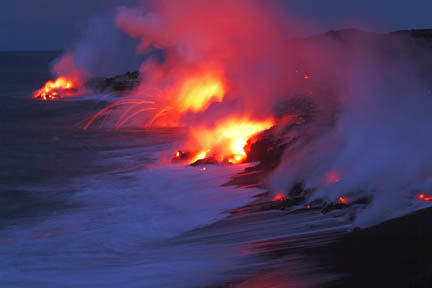
Lava from Kilauea volcano in Hawaii Volcanoes National Park exploded on Saturday as it met the Pacific Ocean at dawn.
Kilauea lava flow keeps
the steamy show rollingVisitors are warned not to disturb
the molten rock
VOLCANO, Hawaii » Bruce Polich is a regular visitor to Hawaii, but he says he's never seen anything like this.
"It's too great for words," the Chicago resident said last week as he watched a stream of glistening lava drop off the edge of the Big Island. "This is Mother Nature at her most beautiful and her most disastrous."
Even Polich's 15-year-old son, Chris, had to admit the sight of Kilauea at Hawaii Volcanoes National Park was "pretty cool."
Lava tipped off a 20-foot cliff into the Pacific Ocean some two weeks ago for the first time in nearly a year.
Yesterday and Saturday, lava was flowing into the ocean at several points, providing a show from the air for helicopter tours, according to the scientists at the U.S. Geological Survey's Hawaiian Volcano Observatory.
The latest flow from Kilauea, dubbed the "Banana flow" for a forested area near the top of the volcano where there were some banana trees, reached the coast along the Wilipea delta.
Although the flow has abated some in the past week, the spectacle has been drawing 2,000 visitors a day, said park spokeswoman Mardie Lane.
Typically, park visitors number 300 to 500 a day. The Polich family joined the throngs last week and was impressed.
Bruce recalls his 1983 visit, which coincided with the beginning of the Puu Oo eruption, and another visit when his son was a toddler.
"This is more fantastic," Polich said.
Yards away, Bernice Patrick gazed at the steam plumes as the lava hit the cooler ocean.
Her husband, Greg, bounced from rock to rock, peering at the red glow of the molten rock.
"It's amazing," he said. "It just goes where it wants. You can't get more natural than this."
The Dyersburg, Tenn., couple were enjoying the second day of a week's vacation. They hiked along a half-mile of road and then across three-quarters of a mile over last year's flow.
"As I was walking on the road, I thought, 'This is more than man-made,'" Patrick said. "There's no way man could do anything like this."
A few visitors poked at the lava with long sticks, which immediately burst into flames. Lane cautioned against touching the lava, for geological, safety and cultural reasons.
"Visitors should resist the urge to test their strength and just discover how beautiful that creation of nature is unto itself," she said.
Getting that close to the lava also is potentially dangerous. The extreme heat kicked up can be intense, and lava picked up by a stick could be flicked onto those standing nearby.
Some native Hawaiians believe lava is the goddess Pele in her body form, Lane said, and it is disrespectful to use rocks or sticks destructively.
"It really is the first time this lava sees daylight as it pushes up from inside the volcano," she said.
Kilauea, the world's most active volcano, has been in continuous eruption since Jan. 3, 1983.
In 2002 a breakout of lava that began on Mother's Day, May 12, reaching the sea on July 19, drew thousands of new visitors. The following year, lava covered Chain of Craters Road in several places, forcing park workers to move huts, toilets, signs and other equipment and establish a new center for visitors.
Hawaii Volcanoes National Park
www.nps.gov/havoHawaii Volcanoes Observatory
hvo.wr.usgs.gov/kilauea
